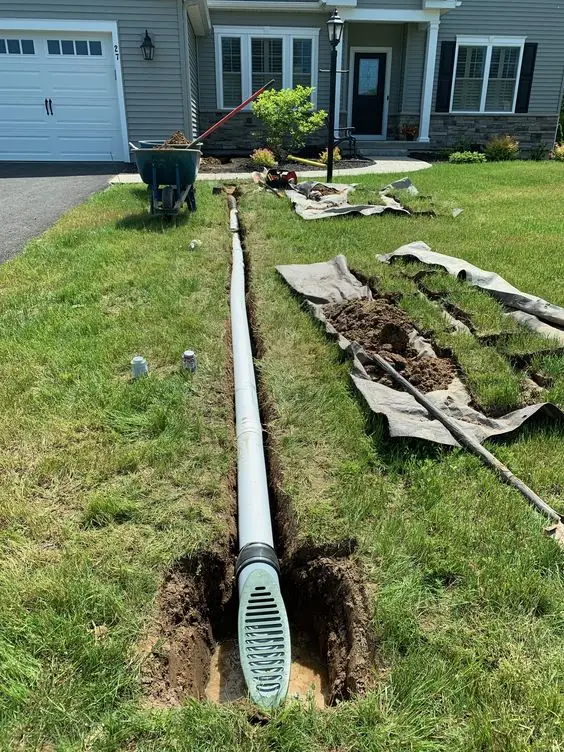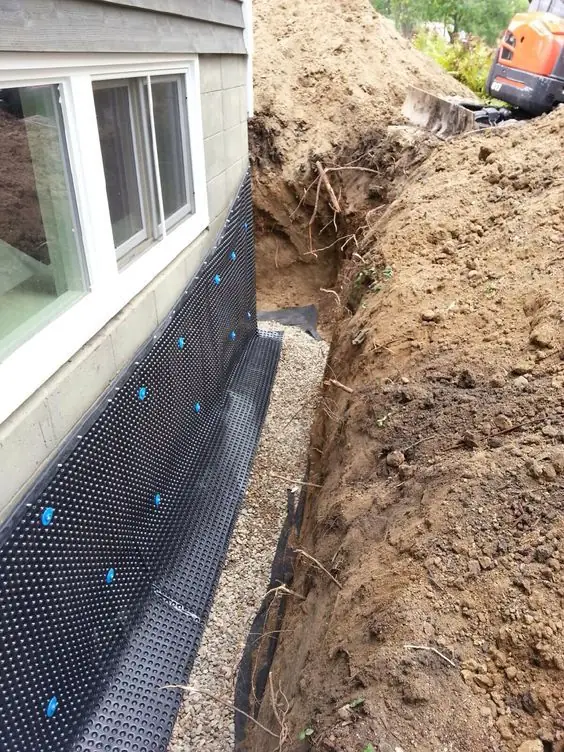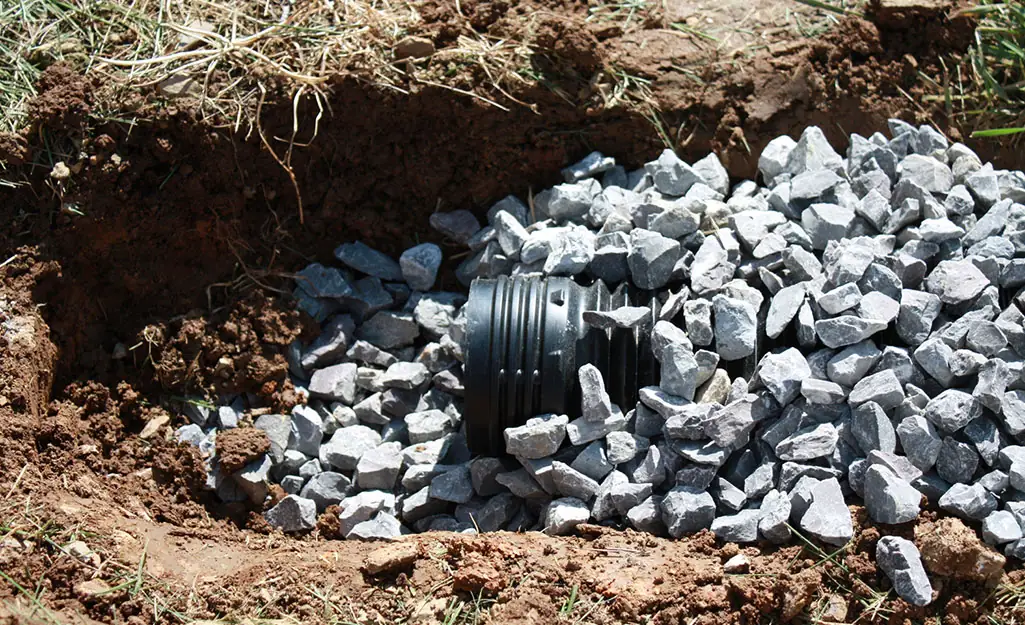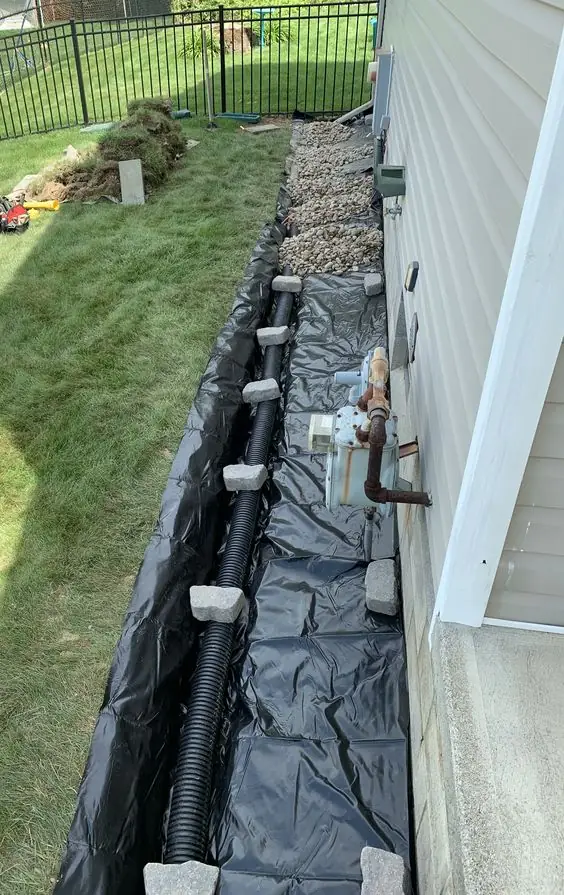What is French Drains System

Did you ever wonder what is a French drains system? Your backyard needs to have good drainage because it can prevent landslides and water damage and keep your basement dry. It will also improve the stability of the foundation of your house and the soil around your property.
What is a French Drain System and How Does it Work?
For a lay person, a French drain looks like any other drainage system that is decorated with rocks to blend in with the rest of the backyard. An easy way to identify this type of drain is to look for an exposed pipe at the bottom of a downward slope.
When you hear about a thing associated with France, you usually think that it must be something fancy, expensive, and complicated, but in this case, it is none of these things. French drains are really nothing more than a shallow hole with a perforated pipe covered with water-permeable material under a thin layer of gravel or small rocks.
The main purpose of this system is to funnel water from some undesirable place in your house (most typically, its foundation) to a place where you like to store the excess water from the rain. For this purpose, you can install an underground cistern or make a seasonal pond in your garden.
How does it work? Everything is pretty simple. Gravity causes the water to go into the trench, and because it’s filled with gravel, water gets to the pipes. Since they are perforated, water flows right into them and then flows down into your reservoir of choice or municipal drainage.

How Much Does it Cost to Install French Drains?
Before you begin your project, check your local prices for the materials and any extra cost if you plan to hire a professional. While you can do this project by yourself, we recommend that you hire a professional since it can be quite exhausting to dig a long ditch and lay all the gravel. What’s more, professionals have the competence to make sure that the system runs smoothly and efficiently, and they usually give a guarantee for their work, so if the system stops functioning, they will fix it without any extra fees.
The cost of hiring a professional can be anywhere between $5000 and $18000 if you are building interior drainage. The cost of materials doesn’t vary that greatly, but there is still a noticeable difference. Expect to pay around $25 per linear foot for your outside French drains and about $65 per linear foot for indoor drains systems due to the expensive membranes that you will need to get and the extra work hours that are required to build this type of drainage.
Why Should You Build a French Drain System Instead of Other Drainage Options?
There are several advantages that French drains have over other popular drainage systems. First, gutters will only funnel water that runs off the roof of your house, whereas French drains redirect water at ground level. This means they will be able to deal with the issue of pools of water that tend to form in low parts of your backyard during heavy storms by moving this water to a special container or just draining it to a street or any other desirable spot.
Another advantage of this type of drainage is that it can prevent the water from getting to your basement through the foundation of your house. The water can get into the cracks of the foundation and go straight into your basement and damage the walls and furniture. By installing French drains you make sure that the water close to your basement will simply be rerouted and unloaded somewhere else. If the water continues to leak into your basement, even though you have an outdoor drain system, you will have to install an indoor drainage system.
How to Install French Drains in a Yard
While installing this type of drain may seem difficult, it can be done by a skilled person that has experience doing DIY projects. This project can be done with a few basic materials and some gardening tools that every household normally has. Before you start your DIY project, make sure to check out local project requirements and whether you need to have any permits. French drains are allowed pretty much everywhere, but sometimes they may be prohibited in areas with unstable and sensitive environments such as wetlands and reclamation grounds. When you have sorted all of this out, you are ready to start the construction.
1. Dig a Trench

First, you will have to dig out a trench, even if you are building indoor drains. Start by digging a trench at a slope; around 1 inch per 8 linear feet should be enough. Direct the slope to the spot you want to drain/store rain from the drain. To measure the slope, take two stakes and connect them with a rope, then place them 8 feet apart and level the string and measure the height of both stakes. The lower one should be 1 inch higher. The width of the trench should be around 12 inches to leave enough space for the pipe and for the rain to drain smoothly. The depth should be anywhere from 18 to 24 inches, depending on the soil and slope of your backyard. If you want to prevent the rain from getting to your basement, lay the pipes all around the foundation of your house. The pipes should be lower than the finished floor level and they should be at a slope so they meet at a single spot and the rain can be drained easily.
2. Pour in the Gravel

After you have dug out the trench, pour in the gravel or crushed stones, so they completely cover the bottom of the hole. This layer of gravel should be at least 4 inches deep. To prevent weeds from growing around the pipes, lay the landscaping fabric on top of the gravel. Be sure to get one that is water-permeable, so the rain can still get to the pipes.
3. Lay down the Pipes

There are two types of pipes you can use: rigid pre-drilled PVC pipes or flexible drain pipes with pre-cut slits. PVC ones usually last longer, but if they ever clog up, you will have a hard time unclogging them, which will most likely result in you hiring a professional plumber to do it for you. Flexible pipes cost less, and you will have an easier time installing them.
When you are using PVC pipes, it is recommended that you add a 45-degree angle joint to the pipe at the highest point. Install it in a way so you can access it with ease. This will allow you to clean your pipes regularly to prevent any clogs from forming.
The most important thing to remember when you are laying pipes of any kind for this drainage system is to face the holes downward. These drains are designed in a special way, so the water can enter from the bottom of the pipes, even if that sounds counterintuitive.
There is a way to build this drainage system without pipes, with just a few layers of landscaping fabric in between two layers of gravel. This setup can be functional, but it’s less consistent, so our recommendation is to use pipes when installing a drain system.
4. Pour in the Second Layer of Gravel
Start with wrapping the pipes with landscape fabric. This will prevent the roots and dirt from clogging the holes and slits. Finally, fill up the rest of the trench with gravel. Alternatively, you can leave a bit of space to add colorful glass rocks to make the drain system a bit more appealing. You can cover it with dirt as well, but that might complicate future maintenance, so have that in mind.
How to Install French Drains in the Basement
If there is still water that leaks into your basement even though you have a functioning outdoor drainage system, you will need to install an indoor French drain system. The process of installing one of these indoor systems is similar to building an outdoor one, but there are a few extra steps you will need to pay close attention to. First, dig the trench and lay down the pipe. You don’t need to add gravel and landscaping fabric because the pipes are surrounded by concrete. Connect one end of the pipes to the outdoor drainage. Now since the water is on a lower level than the outside, you will need to use a pump. Connect the pump to the end that is not connected to the outside system. Finally, you can fill the hole with gravel and add a rubber sheet on top or install metal bars. To get a more detailed explanation, check out the video below.
FAQ
Yes. If you don’t maintain the drains regularly, they can clog up. When this happens, rain can build up around the pipes and create exactly the situation that the drainage was supposed to solve.
Use a drain cleaner of vinegar and baking soda every two months to keep your drain clean and functional. Hopefully, now you know what is a French drains system, how it works, and why you should build one in your backyard. Make sure you understand every step and have a firm grasp on how to build functioning drainage systems before you start to work. Good luck with your house project, and see you soon!